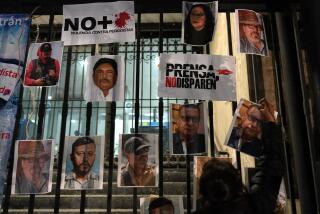The Ruben Salazar files
- Share via
Forty years of obfuscation about the suspicious death of Times journalist Ruben Salazar is long enough. Los Angeles County Sheriff Lee Baca owes it to the people of L.A., and proponents of civil rights everywhere, to release department records that have been sealed since the crusading columnist’s slaying by a deputy on Aug. 29, 1970.
Salazar, who was honored recently with a postage stamp and is a namesake of schools, parks and awards throughout the region, was killed at the height of the worst rioting Los Angeles had seen since the Watts conflagration five years earlier. A Times reporter since 1959, he had left the paper about a year before his death to become news director at the Spanish-language station KMEX-TV, and on the day he died at age 42, he was covering an anti-Vietnam War protest in East L.A. that had degenerated into looting and violence.
Unanswered questions about his slaying, and the lack of official action against the deputy who killed him, continue to cloud the case, angering not only Salazar’s surviving family and friends but those moved by his pioneering coverage of the challenges faced by Mexican Americans.
Among them: Why do photographs taken by a magazine journalist and testimony from witnesses suggest that a shotgun-wielding deputy herded unarmed men into the Silver Dollar bar on Whittier Boulevard moments before other deputies fired tear gas into the bar? Salazar, who had stopped in to the Silver Dollar for a beer, died after being struck in the head by one of those tear-gas canisters — a torpedo-shaped missile designed to penetrate plywood barriers and not intended for use in crowd control — yet prosecutors declined to pursue charges even of involuntary manslaughter against the deputy who fired it. Why did the Sheriff’s Department subsequently refuse to release its training manual on the use of tear gas? Is it coincidental that Salazar had told colleagues and officials with the U.S. Commission on Civil Rights in the weeks before his death that he was being tailed because his coverage of police brutality had angered law enforcement officials? Was Salazar truly under surveillance?
Hoping for some answers to those questions, Times reporter Robert J. Lopez filed a California Public Records Act request for eight boxes of records on Salazar’s death kept by the Sheriff’s Department. Baca initially refused, but on Tuesday, as the county Board of Supervisors ordered a review of whether the records were public, he changed his mind and directed his staff to go through the documents and determine what could be released. If Baca continues to withhold important files, it will only rub salt in a still-open wound.
More to Read
Sign up for Essential California
The most important California stories and recommendations in your inbox every morning.
You may occasionally receive promotional content from the Los Angeles Times.










